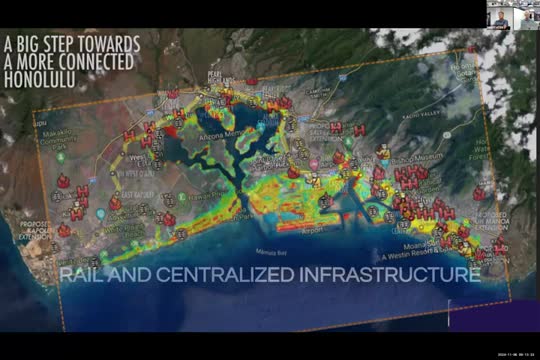Experts warn of looming infrastructure crisis from sea level rise
November 06, 2024 | Hawaiʻi Community Development Authority, Executive , Hawaii
This article was created by AI summarizing key points discussed. AI makes mistakes, so for full details and context, please refer to the video of the full meeting. Please report any errors so we can fix them. Report an error »

During a recent government meeting, discussions centered on the critical state of Honolulu's infrastructure, particularly in relation to the risks posed by climate change and sea level rise. The meeting featured insights from the chair of the AIH Honolulu's Design for Risk and Resiliency Committee, who emphasized the urgent need to address vulnerabilities in the city's sewer and wastewater systems.
The committee, founded in 2019, has grown to approximately 80 members, focusing on identifying risks associated with rising sea levels and groundwater issues. The chair highlighted that areas such as Kewalo Basin and Kaka'ako Makai are particularly at risk, with projections indicating significant inundation levels. The interplay between rising sea levels and groundwater, which can exacerbate flooding, was a key point of concern.
A significant issue discussed was the current state of the wastewater systems, described as an \"Achilles heel\" for development in the region. The chair explained how heavy rainfall and groundwater flooding can lead to stormwater infiltrating the sewage system, overwhelming treatment facilities and resulting in the discharge of untreated sewage into local waters. This situation not only poses environmental risks but also leads to public health concerns, including beach closures.
The meeting also touched on outdated engineering practices that prioritize rapid water drainage over sustainable management. The chair advocated for a shift towards a \"1 water\" approach, which emphasizes slowing down and spreading water across the land to enhance groundwater recharge, a method rooted in traditional practices.
The discussion concluded with a stark reminder of the challenges facing Honolulu's infrastructure, exacerbated by insufficient funding for maintenance and upgrades. The committee's ongoing efforts aim to rethink and redesign systems to better withstand the impacts of climate change and ensure the resilience of the city's critical infrastructure.
The committee, founded in 2019, has grown to approximately 80 members, focusing on identifying risks associated with rising sea levels and groundwater issues. The chair highlighted that areas such as Kewalo Basin and Kaka'ako Makai are particularly at risk, with projections indicating significant inundation levels. The interplay between rising sea levels and groundwater, which can exacerbate flooding, was a key point of concern.
A significant issue discussed was the current state of the wastewater systems, described as an \"Achilles heel\" for development in the region. The chair explained how heavy rainfall and groundwater flooding can lead to stormwater infiltrating the sewage system, overwhelming treatment facilities and resulting in the discharge of untreated sewage into local waters. This situation not only poses environmental risks but also leads to public health concerns, including beach closures.
The meeting also touched on outdated engineering practices that prioritize rapid water drainage over sustainable management. The chair advocated for a shift towards a \"1 water\" approach, which emphasizes slowing down and spreading water across the land to enhance groundwater recharge, a method rooted in traditional practices.
The discussion concluded with a stark reminder of the challenges facing Honolulu's infrastructure, exacerbated by insufficient funding for maintenance and upgrades. The committee's ongoing efforts aim to rethink and redesign systems to better withstand the impacts of climate change and ensure the resilience of the city's critical infrastructure.
View full meeting
This article is based on a recent meeting—watch the full video and explore the complete transcript for deeper insights into the discussion.
View full meeting
